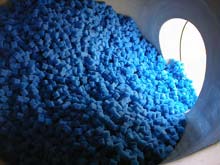Ecology, The Environment and Conservation
This complex theme deals primarily with interactions between organisms and the environmental factors that impact them, but to a greater extent between individual inanimate environmental factors.
innovations-report offers informative reports and articles on topics such as climate protection, landscape conservation, ecological systems, wildlife and nature parks and ecosystem efficiency and balance.

Solid management, natural resilience both key to sockeye success
The resilience of sockeye salmon runs in Alaska’s Bristol Bay -– after a century of fishing they’re as healthy as they’ve ever been – is about strength in numbers.
It’s not just an abundance of fish, although the numbers returning to spawn is tens of millions more than the total across the lower 48 states and prudent actions by fishermen and the Alaska Department of Fish and Game have helped make it a classic example of a sustainable fishery.
As it turns out, it’

Greenhouse gas might green up the desert
Weizmann Institute study suggests that rising carbon dioxide levels might cause forests to spread into dry environments
Missing: around 7 billion tons of carbon dioxide (CO2), the main greenhouse gas charged with global warming. Every year, industry releases about 22 billion tons of carbon dioxide into the atmosphere. And every year, when scientists measure the rise of carbon dioxide in the atmosphere, it doesn’t add up – about half goes missing. Figuring in the amount that could be s

UC Riverside scientists modify existing chemical scrubber to environmentally friendly, all-natural filter
Converting one third of chemical scrubbers worldwide could save up to two billion dollars each year
Scientists at UC Riverside have pushed the current limit of a technique for biologically removing hydrogen sulfide from sewage emissions a step further. Marc Deshusses, associate professor in the department of chemical and environmental engineering, and his postdoctoral researcher, David Gabriel, report in the Proceedings of the National Academy of Sciences (PNAS) that they have modifi

Roads pave the way for weed invasions
While it is well-established that roads can help spread invasive weeds, one new study shows that improved roads are worse than primitive ones, while another suggests that roadless areas act as refuges for native species against invasions.
Cheatgrass, knapweeds and other non-native plants have invaded nearly 125 million acres of the American West. Roads promote invasion because vehicles can transport non-native seeds into uninfested areas, and disturbed roadsides give weed seeds a place to g

Scientists’ research helps to safeguard greenbelt and promote affordable housing
The number of housing developments on greenfield sites could be significantly reduced thanks to technology, pioneered by University of Greenwich environmental scientists, which can quickly decontaminate polluted and brownfield land, ready for building affordable environmentally friendly housing.
nown as Accelerated Carbonation Technology (ACT), this new process can treat contaminated land and hazardous waste in minutes rather than the days or weeks required by some conventional methods.

A new, dechlorinating bacterium
Several industrial activities of the previous decades resulted in serious contamination of groundwater. For instance, polyvinyl chloride (PVC) production and related activities cause annual underground releases of 137 tonnes of 1,2-dichloroethane (1,2-DCA) in the USA (1988-1999). The latter molecule has an environmental half-life of about 50 years, is the most abundant groundwater pollutant of all chloroethenes and –ethanes, and is a suspected carcinogen. Its physico-chemical properties result in a s